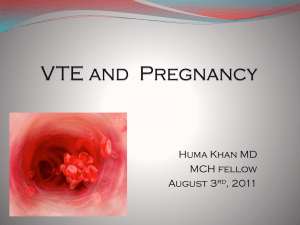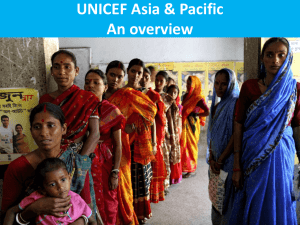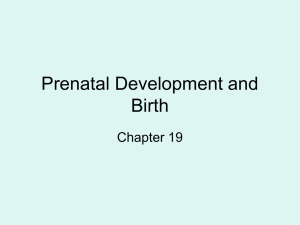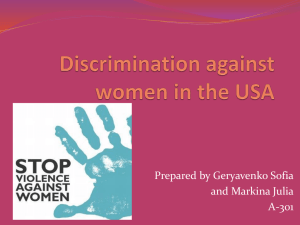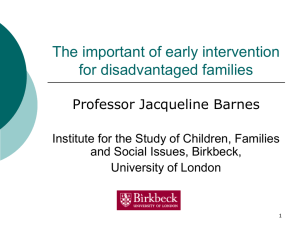Case study 15 - GURU OB & GYN
advertisement
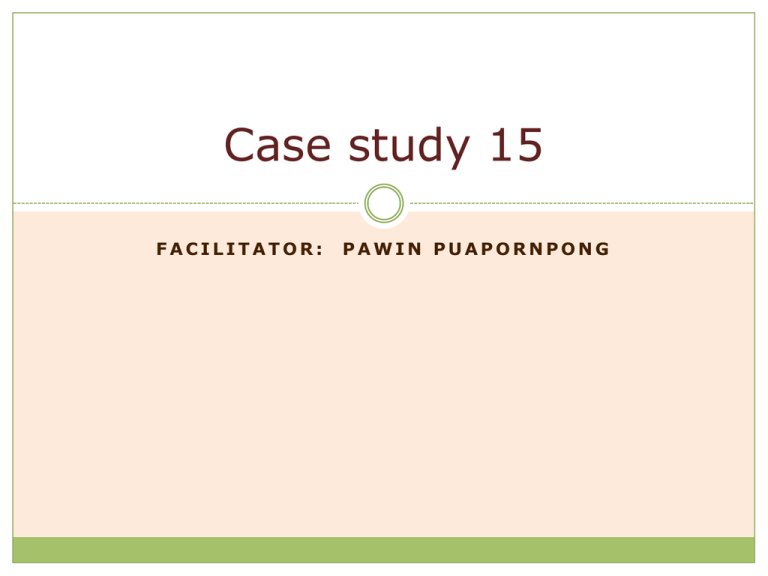
Case study 15 FACILITATOR: PAWIN PUAPORNPONG Case หญิงไทย อายุ 21 ปี อาชีพ ไม่ได้ทางาน(ทาโรงงาน ฝ่ ายผลิตก่อนท้อง) G1P0A0; GA 34+4 wk. by ultrasound มา รพ. ด้วยปวดท้อง 12 ชม. ก่อนมา รพ. Duration 30 s Interval 5 min อาการปวดเกร็ง ทัว่ ๆทั้งท้อง ร้าวไปหลัง ระหว่างนอนบนเตียง ปวดถี่ขึ้น ไม่สมา่ เสมอ ไม่มีน้ าเดิน ไม่มีมกู เลือดออก ไม่มีจุกแน่ นหน้าอก ไม่มีกระทบกระแทก ไม่มีตาพร่า ไม่มีแขนขาอ่อนแรง ไม่มีปวดศีรษะ ลูกดิ้ นดี ปั สสาวะอุจจาระปกติ ไม่มีประวัติ trauma ต่อครรภ์ Medical history No food/drug allergy Underlying: Congenital heart disease (aortic regurtigation, VSD?) Status post Ross’ procedure and closure of VSD ตอนอายุ 8 ปี ที่ รพ. เด็ก กินยา แล้ว Lost follow up รพ. เด็ก Medical history Underlying: Congenital heart disease (aortic regurtigation, VSD?) 9 m PTA functional class 12, มีอาการ chest pain ไป รพ. หนองเสือ ddx NSTEMI refer ไป รพ. เอกปทุม ทา Echo moderate-severe AR, LVEF 56%, LVH dx: moderate-severe AR with acute CHF ตรวจไม่พบสาเหตุของ acute CHF (จึงเชื่อว่าเป็ นจาก progression of underlying disease) BP 119/50 ได้ยา Enalapril (5) ½ x2 po Medical history Underlying: Congenital heart disease (aortic regurtigation, VSD?) 6 m (30/3/56) PTA อาการปกติ ไป follow up รพ. เอก ปทุม ครั้งสุดท้าย ได้ยา Enalapril เหมือนเดิม แล้ว loss follow up ไปเนื่ องจากย้ายที่อยู่ หลังจากนี้ ทราบว่าตั้งครรภ์ ประกอบกับยาที่ได้จาก รพ. หมดพอดี จึงไม่ได้ รับประทานยาต่อ ไม่ได้ไปรักษาที่อื่น ไม่มีซื้อยารับประทานเอง ไม่ทราบข้อมูลว่าขณะรับประทานยา enalapril นี้ ไม่ควรตั้งครรภ์ Personal Hx No smoking, alcohol, IVDU Second-hand smoking สามี ~1 pack-year GYN History No STD LMP: 15/3/56 เคยใช้ยาคุมและถุงยาง เลิกใช้ยาคุมไป 10 เดือน PTA เนื่ องจากช่วง หลังไม่ได้อาศัยอยูก่ บั สามี ผูป้ ่ วยไม่ทราบว่าการตั้งครรภ์สามารถเพิ่มความรุนแรงของโรคหัวใจที่ เป็ นอยู่ จึงไม่ได้พยายามป้องกันการตั้งครรภ์โดยเคร่งครัด OB History Primigravidarum ANC • 1st ANC at MSMC, at GA 31+5 wk by LMP/32+2 wk by U/S; ANC ทั้งหมด 3 ครั้ง • ครั้งที่ 1 อาการปกติ ลูกดิ้ นดี ตรวจ BP 120/104 ; first ANC lab พบมีซีด Hb 9.9 mg/dL, MCV 66.8 fL, มี Anisopoikilocytic work up OF: neg, DCIP: pos. แพทย์เริ่มให้ FF (200) 1x3 และยังไม่ได้ w/u ต่อ ที่ไม่ได้ฝากครรภ์ต้งั แต่แรกๆ เนื่ องจากมีปัญหากับที่บา้ น และยุง่ กับงาน จึงลาออกมา หลังจัดการกับปั ญหาที่บา้ นได้ OB History ANC • ครั้งที่ 2 มี BP สูง 162/59 repeat 120/59; urine pro/sug neg/neg OB History ANC • ครั้งที่ 3 มี edema 1+, BP 160/61, urine pro/sug: neg/neg; อาการอื่นๆ ปกติ ANC risk: • • • • • • Underlying congenital heart disease, ACEI use during early pregnancy, late ANC, Anemia (Hb 9.9 mg/dL), Hypertension during pregnancy (UA: initially no proteinuria, มี proteinuria 2+ at ward) Second-hand smoker Risk of second-hand smoker The most serious complications — including stillbirth, premature delivery, and low birth weight Ear infections (which can lead to hearing problems) Upper respiratory infections Bronchitis Pneumonia Reduced lung function Asthma At ward BP สูง 180/100 repeat 170/80 W/U UA: protein 3+ (uncentrifuged) at ward Protein 2+ (centrifuged) at Lab dx: severe preeclampsia ได้ MgSO4 10MgSO4 4g IV slowly push 50%MgSO4 20g + 5%DW1000ml IV 50 ml/hr. (1g/hr.) Lab CBC: Hb 13.0 mg/dL MCV 71 fL: Hypochromic microcytic anisopoikilocytic Coagulogram normal; CXR ,EKG Physical exam v/s: BT36.7, PR104bpm,RR 26/min, BP 170/80 mm Hg GA: A thai pregancy female, good conciousness HEENT: not pale conjuctivae, anicterae Heart: Corrigan's pulse,Watson's water hammer pulse, LV heaving, thrill, diastolic rumbling murmur gr. 4/6 at erb's point with pansystoric murmur at apex, PMI at 6th ICS Lung: normal breath sound, no adventitious sound Abdomen: Fundal weight 32 cm FHR 140 bmp Lie longitutinal, vertex presentation, fetal movement positive, uterine contraction position, Duration 40" intercal 2'30", Intensity +++ PV : Dilatation 3 cm, effacement 80%, station -1, membrane intact EXT : Pitting edema 1+ Neuro Exam : grossly intact , normoreflexia (+2 all limb) This case อาการเจ็บครรภ์ทิ่regular และมีความถี่มากกว่า 4 ครั้ง ต่อ 20 นาที ร่วมกับมี cervical change ได้แก่ dilatation >1 cm และ Effacement > 80% เท่ากับมีความ เสี่ยงต่อการมี preterm labor Discussion: AORTIC REGURGITATION Hemodynamics in pregnancy Important physiologic changes: Increase blood volume 40-50% (≈ 1500 ml) Increase cardiac output 50% (highest during 28-32 wks and postpartum) Decrease in total peripheral resistance Hypercoagubility Hemodynamics in pregnancy MAP falls sharply in the first trimester, reaching a nadir by midpregnancy. third trimester may occasionally experience significant hypotension due to venocaval occlusion HR and SV increase as pregnancy progresses to the third trimester. Cardiovascular disease in pregnancy Most common cause of death in pregnant women Diagnosis of cardiovascular disease in pregnancy Symptoms Dyspnea Orthopnea Intermittent dyspnea at night Bloody cough Syncope after physical activities Chest pain assoc. with physical activities or mood Signs Cyanosis, clubbing Engorged neck vein Heart murmur Persistent split second heart sound Cardiomegaly on chest radiograph Severe arrhythmia Signs of pulmonary hypertension e.g. left parasternal lift, loud P2 Investigations EKG Echocardiography Chest x-ray Cardiovascular conditions unsuitable for pregnancy History of heart failure, transient ischemic attack, arrhythmia or stroke Severity (NYHA) Class III or class IV Left-sided obstruction (mitral valve area ‹ 2cm2 or aortic valve area ‹ 1.5cm2 or peak left ventricular outflow tract › 30mmHg on echo) Ejection fraction ‹ 40% Anticoagulants use Options 1. Adjusted-dospeak anti-Xa 4 hrs after injection) 2. Adjusted-dose UFH every 12 hours thoughout pregnancy ( aPTT at least 2x controlled level or antiXa heparin level 0.35-0.70 unit/ml) 3. LMWH or UFH for the first 13 wks, then switch to warfarin (INR 2-3) and switch back to LMWH or UFH before partum High risk: warfarin throughout pregnancy then switch to LMWH or UFH before partum Teratogenic effect of warfarin on first trimester ยาผ่านรกได้ ดังนั้ นถ้าให้ในช่วง e LMWH twice daily throughout pregnancy (adjusted to 3 สัปดาห์กอ่ นคลอดจะเสี่ยงต่อภาวะเลือดออก ผิดปกติในทารก Specific cardiovascular disease: Aortic regurgitation (AR) ลิ้ นปิ ดไม่ดี → บางส่วนของ Cardiac output ย้อนกลับลง มาสู่ LV ในระยะ diastole → LV ขยายเพื่อเพิ่ม stroke volume แต่มกั จะไม่เพียงพอที่จะทาให้ได้ปริมาณ CO เหมือนปกติ → ความดันใน LA เพิ่ม → pulmonary congestion Symptoms: fatigue, dyspnea → syncope, chest pain Pregnancy --> IUGR AR and pregnancy โดยทัว่ ไปแล้ว AR ทนต่อการตั้งครรภ์ได้ดี จาก Decrease in total peripheral resistance (decreased regurgitant volume) Increased heart rate (decreased regurgitation time) AR ที่มี decompensation ใน pregnancy มักมี เหตุกระตุน้ ในรายนี้ ตรวจพบ SBP สูง ซึ่งไม่ typical สาหรับ decompensation ของ AR ตามปรกติ (ซึ่ง SBP มัก ปกติหรือค่อนข้างตา่ โดยเฉพาะในรายนี้ ที่มี decrased LVEF แล้ว) จึงเชื่อว่า SBP ที่สงู ขึ้ นนั้น เป็ นสาเหตุ (primary) ส่วน decompensation นั้นเป็ นผล (secondary) This case SBP ที่สงู ขึ้ นในผูป้ ่ วยรายนี้ ใน second ANC visit ยังไม่ ทราบเหตุชดั เจน คงไว้เพียง differential ถึง gestational hypertension preeclampsia และ chronic hypertension จาก underlying disease ที่อาจมีอยูเ่ ดิม แต่เพียงบังเอิญตรวจได้คา่ BP ปกติใน ANC visit แรก Management Antenatal control for AR ควรได้รบ ั Control BP และ regurgitation (ดูจาก echoฯ หรือ pulse pressure) โดยใช้ยา pure vasodilators Nifedipine (long term-oral) Hydralazine (long term-oral; หรือใน acute control ให้ IV form) Labetalol (acute control-IV) อาจให้ diuretics ถ้ามี volume overload เคสนี้ consult internal medicine for antenatal and perinatal management แต่ผปู้ ่ วยไม่ได้มาตามนัด Management Perinatal management หลักการเหมือน antenatal choice of acute control of BP เป็ น IV labetalol (ติดปั ญหายาหมด รพ. จึงเปลี่ยนเป็ น hydralazine single dose) ในรายนี้ เนื่ องจาก exacerbant พบว่าเป็ น preeclampsia นอกจากการคุม BP ด้วยยาแล้ว ย่อมต้องได้รบั specific treatment ของ preeclampsia คือ termination of pregnancy ดังจะกล่าวต่อไป Discussion: ANEMIA Anemia in pregnancy Physiologic cause Plasma volume Red cell mass Phathologic cause Decrease production Increase destruction Blood loss This case Hb 9.9 mg/dL, MCV 66.8, Microcytosis 2+, Anisopoikilocytois ได้ FF(200)1x3 ~1 month-> F/U Hb 13, MCV 71.6 work up OF: neg, DCIP: pos. This case Iron deficiency anemia น่ าจะมีส่วนบ้าง เนื่ องจากได้รบ ั Ferrous fumarate (FF) แล้ว Hb เพิ่ม MCV เพิม่ Hemoglobinopathy DCIP positive แต่ไม่ได้ work up ต่อ Pre-eclampsia รายนี้ หลังได้รบ ั FF แล้ว Hb ขึ้ นสูงถึง 13 g/dL ซึ่งน่ าจะเป็ นค่าที่สงู กว่า baseline ในรายที่มี underlying เกี่ยวกับ hemoglobinopathy ดังที่ screen พบ เชื่อว่ามีผลจาก hemoconcentration ของ pre-eclampsia จึงที Hb เพิ่มสูงได้ถึง 13 Discussion: ACEI EXPOSURE DURING 1st trimester Teratogenic effects of ACEIs in 1st trimester Only class of antihypertensive drug precipitating an increased risk of cardiac malformations and neural tube defects (Cooper WO et al, 2006) Similar cardiac risks seen in other classes of antihypertensive drug (Li DK et al, 2011; Lennestal R et al, 2009) Underlying hypertension has greater association (Li DK et al, 2011, Caton AR et al, 2009) Still ACEI (FDA class D) is not recommended in women of child bearing potential to prevent 1st trimester and subsequent exposures This case Rt. pyelectasis in this case may be associated with ACEI Discussion : Preeclampsia Terminology Gestational hypertension preecclampia mild preecclampsia Severe preecclampsia Ecclampsia Superimposed preeclampsia on chronic hypertension Chronic hypersion Pathophysiology In this case Severe preecclampsia Laboratory CBC LFT BUN, Cr Ecclampsia prodrome เจ็บที่ลิ้นปี่ หรือ ใต้ชายโครงขวารุนแรง Throbbing (Frontal) อาการผิดปกติทางสายตา (ตาพร่ามองไม่ชด ั ) อาเจียน ตื่นตัวทางประสาท (Hyperreflexia) ปวดศีรษะมากแบบ Management ป้องกันการชัก (MgSO4) ลดความดันโลหิต (Dexametazone) ชักนาการคลอด (Oxytocin, Expogin) ตรวจติดตามสุขภาพทารกในครรภ์ ควบคุมสมดุล Fluid & Electrolyte ป้องกันและแก้ไขภาวะแทรกซ้อน การดูแลทัว่ ไป


